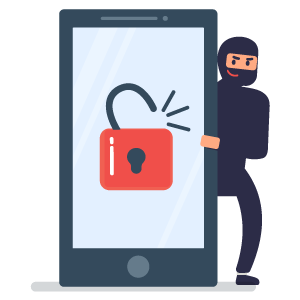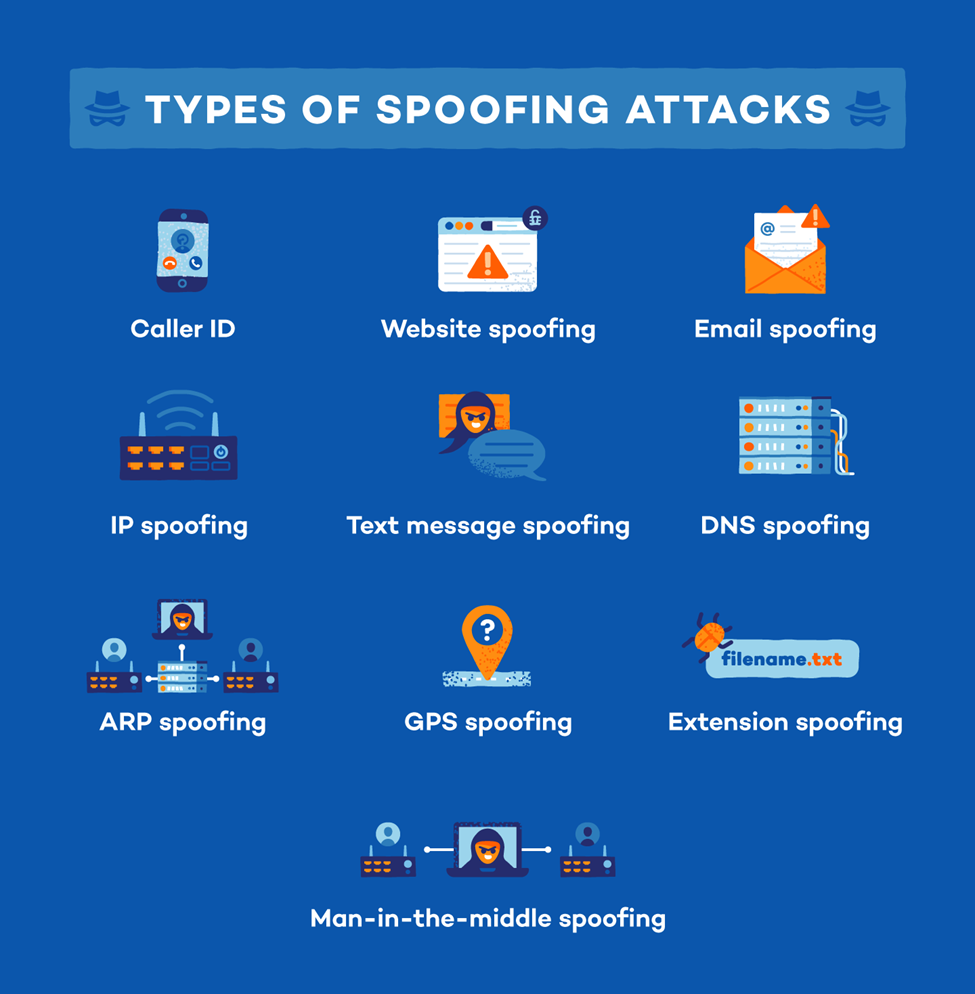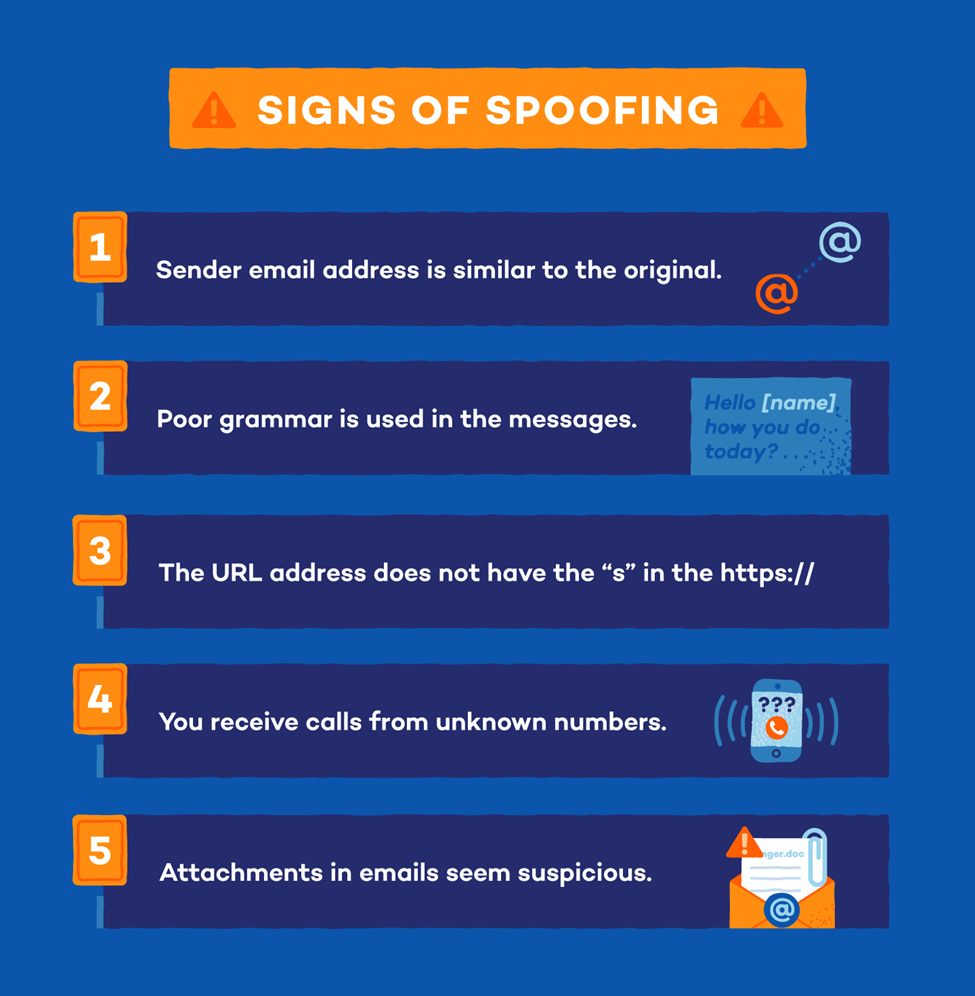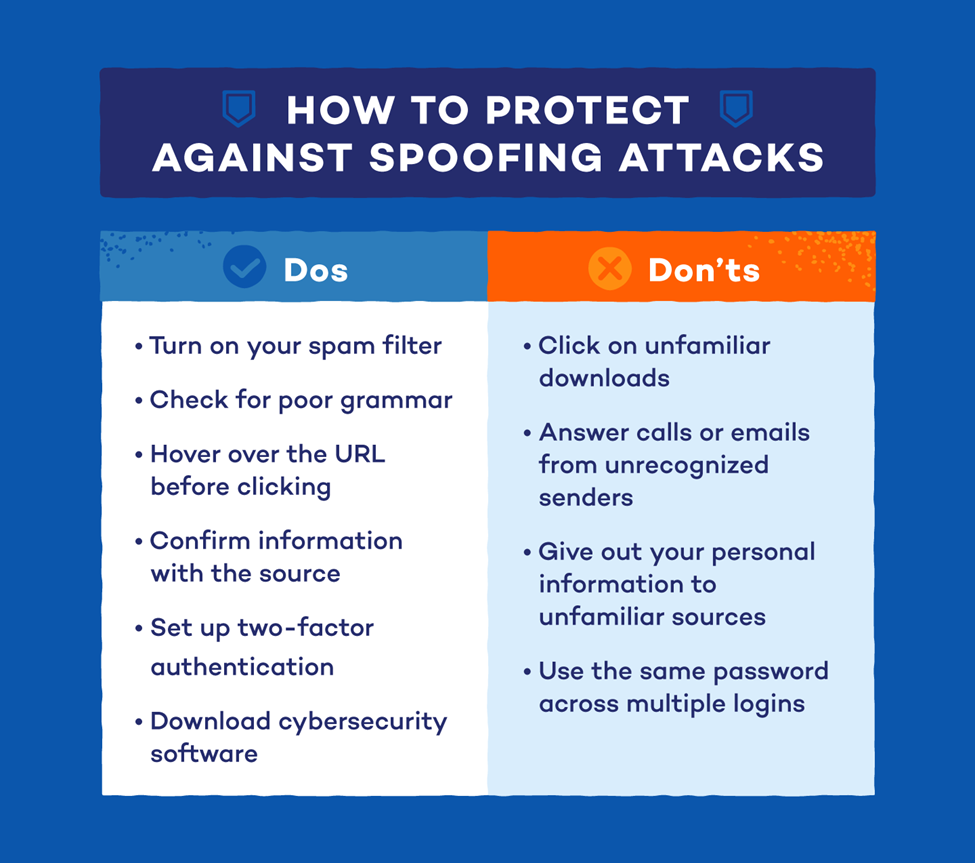
Spoofing is when a cyber criminal disguises themself as an individual, business, or entity to commit malicious acts.
Cyber criminals utilize various tactics to spoof their identity, ranging from spoofed email addresses, websites, or phone numbers to more advanced strategies like fraudulent IP addresses, Domain Name Servers (DNS), or Address Resolution Protocol (ARP).
Regardless of the tactics used, the goal of a spoofing scam is to steal from victims and damage their reputations.
Cyber criminals leverage common social engineering maneuvers and employ fake email addresses, websites, or phone numbers to trick victims into divulging confidential information, downloading attachments, or clicking links that install malware.
Scammers ease the average victim's suspicion by relying on entities most people are familiar with, such as recognizable brands, financial institutions, government offices, and so on. As a result, their guard is let down, making it possible to take advantage of the human nature of trust.
Spoofing is often the first step in larger cyber threats, such as large-scale ransomware attacks on computer networks.
What Are Different Examples Of Spoofing?

Source: Panda Security
Email Spoofing
In email spoofing, a cyber criminal uses a fake email address to commit a malicious act. Depending on the email spoofing tactic, they may spoof the email address, email sender's name, or both. Additionally, the cyber criminal can assume multiple identities: the sender, the company, or both.
For example, a scammer can assume a generic-sounding identity, like Joan Smith, and email one or several employees from the email address [email protected]. Joan Smith doesn't work for XYZ Widgets, a large multinational company, but the recipient works there. They don't know Joan isn't an actual employee and, when the email hits their inbox, are inclined to trust the request since the company logo and other brand hallmarks are present.
Like phishing threats, spoofed emails use urgent and convincing language to spur the recipient into immediate action. This sense of urgency limits the chance for hesitation and questioning and convinces the recipient that they are helping and doing the right thing.
Caller ID Spoofing
Caller ID spoofing is a common tactic that uses a phone number that appears to come from your area code. We are all more likely to answer a call when we see it is a local number.
When you answer their call, cyber criminals use social engineering tactics to keep people on the phone and trick them into taking action.
The cyber criminal may pretend to be a police officer. Because the caller ID looks authentic, the victim is convinced to pay fines that don't exist and provide confidential information, all under the threat of being arrested.
Some cyber criminals even tell the victim to call them back on the number if they don't trust them. This advanced social engineering technique strengthens the relationship and gives a sense of legitimacy to the call.
Website Spoofing
Website spoofing uses a fake website that looks legitimate. A spoofed website looks exactly like the actual website—the logo, branding, colors, layout, domain name, and contact details are all the same. It's challenging to identify a spoofed website without closely inspecting the domain name or looking for minor flaws in the text.
Cyber criminals use spoofed websites for various reasons, including collecting login details, stealing credit card information, installing malware, or other malicious act. Often the victim receives a spoofed email that directs them to the spoofed website.
Text Messaging Spoofing
Text messaging spoofing uses a spoofed phone number to send malicious text messages. The cyber criminal hides behind the phone number, sender name, or both. This type of spoofing relies on advanced research to understand which types of text messages will entice the recipient to open and respond.
The text message may include a phone number for the recipient to call or a link to a malicious website used to commit other cyber crimes. The text message uses social engineering tactics to convince the recipient to respond quickly.
GPS Spoofing
GPS spoofing sends a fake GPS signal to a GPS receiver which then causes all GPS devices in the area to show an incorrect location. Cyber criminals use GPS spoofing to gain control of vehicles, boats, drones, and anyone relying on a navigation system. GPS spoofing is an advanced tactic that can hijack drones or ships and interfere with military navigation systems.
IP Address Spoofing
IP address spoofing hides the true identity and location of the computer or mobile device used by the cyber criminal. Cyber criminals might spoof an IP address for a network that uses IP address authentication, making it easy to access the network.
Typically, IP address spoofing is used to commit a denial-of-service attack, thereby overwhelming the network with traffic and ultimately shutting it down.
In other scenarios, the cyber criminal aims to hide their location from the recipient. This approach can be used with email or website spoofing to add more legitimacy to the attack.
ARP Spoofing
Address Resolution Protocol or ARP spoofing is an advanced technical cyber attack that connects the cyber criminal's Media Access Control (MAC) address to an actual IP address.
This tactic enables the cyber criminal to intercept and steal data intended for the IP address owner. ARP spoofing is typically used to steal data or commit man-in-the-middle attacks as part of a denial-of-service attack or during session hijacking.
DNS Spoofing
Domain Name Server or DNS spoofing allows cyber criminals to redirect traffic from the intended legitimate IP address to a faked IP address. Cyber criminals may use this spoofing tactic to direct victims to websites that install malware.
Extension Spoofing
Extension spoofing disguises the file type, making it easier to convince the target to download and install attachments. Cyber criminals know that people have been warned against installing executables.
The bad actor may disguise a malware executable with a spoofed extension such as doc.exe. The file displays in the email as newfile.doc, and the recipient does not think twice about downloading and installing it.
Facial Spoofing
Facial spoofing is a new type of spoofing that relies on facial recognition software to unlock devices or access a secure building. This type of spoofing is relatively rare, but with advances in facial recognition technology and more companies using facial recognition as part of their security system, the risks of facial spoofing will grow.
A cyber criminal can use pictures found on social media to build a likeness of an individual and then use this to unlock any security system that uses facial recognition.
How Does Spoofing Happen?
Spoofing happens when cyber criminals take advantage of vulnerabilities in technology or its implementation. If successful, they trick people into believing that the fake email, website, phone call, text message, or other approach is genuine. Cyber criminals rely on savvy social engineering tactics to convince victims that they are safe and making intelligent decisions.
Cyber criminals rely on human behaviors, including trust, seeking help, not reading carefully, and not paying attention to details. These scenarios highlight why it's so crucial that security awareness training programs prioritize reducing human risk.
Ways To Spot Spoofing Before It’s Too Late

Source: Panda Security
Website Spoofing Clues
- If the padlock is missing from the website address bar, the website is not secure and is likely spoofed.
- The URL uses HTTP and not HTTPS. Do not trust websites that do not use the "https" encryption prefix.
- Many websites autofill your username and password. Use a password manager to store your login details to protect against automatically logging into a spoofed webpage. If the password manager does not recognize the website, it will not autofill your login details.
- Spelling errors, broken links, suspicious contact us information, and missing social media badges can all be indicators that the website has been spoofed.
- Website addresses containing the name of the spoofed domain are not the official domain.
Email Spoofing Clues
- Spelling errors or an incorrect domain name in the sender's email address indicate a spoofed email.
- Email language urges you to act quickly, transfer money, or provide confidential information.
- Embedded links that have URLs you don't recognize. Hover your mouse or highlight the URL before clicking to double-check the legitimacy.
- Spelling errors, poor grammar, and unfamiliar language can indicate the email isn't originating from a genuine source.
- Attachments and an email message that urges you to download the attachment. Verify the attachment does not have a hidden EXE extension.
Caller ID, Text Message, or SMS Spoofing Clues
- If the phone number displays without brackets () or dashes -. For example, 4567893543.
- The caller ID is your phone number or looks very similar (e.g., one digit may differ).
- The phone number or caller’s name are hidden.
How to Prevent Spoofing

Source: Panda Security
1. Implement technical controls and procedures to protect against email, website, IP, and DNS spoofing.
2. Put a focus on educating your team about social engineering. Educate your team on how social engineering happens. Use real-world scenarios and training to show how easy it is to be tricked by social engineering.
3. Take advantage of security awareness programs that use flexible learning models to teach adults. Ensure that all training is engaging, relevant, and uses real-world scenarios.
4. Remind employees of the risks that arrive in their inboxes. Use simulations, email newsletters, communication campaigns, and cyber heroes to keep communication about spoofing and cyber security ongoing.
5. Ensure that all applications, operating systems, browsers, network tools, and internal software are updated and secure. Install malware protection and anti-spam software.
6. Provide regular and consistent security awareness training campaigns reminding people of the risks of providing confidential information, passwords, corporate data, and credit card details online.
7. Educate your team about spoofing. Use simulation software and training that includes real-life examples of spoofing attacks.
8. Regularly monitor employee awareness levels of spoofing, social engineering, and other cyber threats with simulations.
9. Create a corporate culture that encourages behavior change. Create a work environment that gives employees the time and resources to develop cyber security awareness.
10. Be proactive in creating a cyber-aware culture. Read The Human Fix to Human Risk to learn step-by-step guidelines on developing an effective security awareness program that stimulates behavior change.
How Phishing Simulations Help Defend Against Spoofing
While spoofing and phishing are different types of cyber attacks, phishing often relies on spoofing to succeed.
Phishing simulations are ideal for measuring employee awareness of social engineering and the risks that come through the inbox. Phishing simulation lets you incorporate cyber security awareness training into your organization using an interactive and informative format.
People see how savvy language is used in emails to steal confidential information and corporate data. Real-time phishing simulations are ideal for reinforcing the indicators of email spoofing and other spoofing tactics.
Phishing simulations give you ten key ways to protect your employees from spoofing attacks
1. Reduces the cyber threat risk level.
2. Increases awareness and alertness of social engineering and spoofing risk.
3. Measures the degrees of corporate and employee vulnerability.
4. Fosters a security-aware culture and develops internal cyber heroes.
5. Changes human behavior to help avoid the automatic trust response.
6. Reinforces security awareness training messages.
7. Creates upper management buy-in for ongoing security awareness training and campaigns.
8. Keeps employees vigilant to spoofing, phishing, and social engineering attacks.
9. Meets industry compliance obligations.
10. Assesses the performance of cyber security awareness training.
Social Engineering
Spoofing is a crucial component of a successful social engineering attack. Cyber criminals use strategic social engineering techniques to convince victims to click links, download attachments, fill-out web forms, and respond to text messages.
Social engineering success requires only one thing: trust. Your employees must understand how social engineering works. Give your employees the training and simulations that allow them to change their behavior.
Spoofing
Spoofing is often used as part of a larger cyber attack. The cyber criminal may use email spoofing to direct a victim to a spoofed website that then installs ransomware on the victim's computer.
Get Valuable Coaching Advice and Protect Your Organization

Learn how you can protect yourself against spoofing and social engineering attacks. Enroll in a 30-minute coaching session with one of our Security Awareness Experts. In this session, a CISO will help you:
- Evaluate your current security awareness program and level of exposure to risk and constraints
- Reduce the human risk factor within your organization
- Define goals, objectives, and key performance indicators to measure results
- Identify the key personnel required to design and execute your security awareness program
- Design an effective internal communication strategy